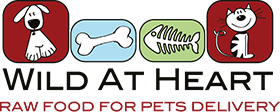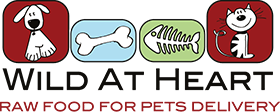 Bones are at the very core of the raw diet. (Some would say that a pet can lead a full healthy life on RMB alone). One important benefit of eating raw (and NEVER cooked) bones is mechanical: the 'natural dentistry' effect. The chewing, crunching and ripping (in case of RMB) actions, naturally 'brush' and 'floss' the pet's teeth while also massaging the gums. This is, of course, much more evident with whole bones, and is the main reason that whole RMB are recommended as part of any raw diet. Other benefits of bones are nutritional: Bones provide a wide range of nutrients.
Bones are at the very core of the raw diet. (Some would say that a pet can lead a full healthy life on RMB alone). One important benefit of eating raw (and NEVER cooked) bones is mechanical: the 'natural dentistry' effect. The chewing, crunching and ripping (in case of RMB) actions, naturally 'brush' and 'floss' the pet's teeth while also massaging the gums. This is, of course, much more evident with whole bones, and is the main reason that whole RMB are recommended as part of any raw diet. Other benefits of bones are nutritional: Bones provide a wide range of nutrients.
- Minerals: Calcium and Phosphorus among many others. Calcium and Phosphorus are not only abundant; they are in good balance to what the body needs. The bones are a living tissue (Raw bones that is) and contain all the minerals that are so important to grow… healthy bones. A healthy dog eating plenty of bones will probably need no mineral supplements whatsoever. No artificial calcium can measures the effect of digesting bones. This is especially crucial for puppies and lactating moms.
- Protein: Not only is there plenty of protein, it is of high quality (unlike the protein 'extracted' from bones). This protein contains all the essential amino acids (other then one which is abundant in meat) needed. As far as amino acids, again, a diet of RMB will provide everything the pet needs.
- Fatty Acids: Bones contain plenty of fat and fatty acids (mostly Omega 6) Chicken and pork are the richest in that department.
- Fat Soluble Vitamins: Raw bone's fat contains deposits of Vitamins A, D and E. (They vanish when the fat breaks down when cooked)
- Marrow: The marrow has plenty of nutrients, mainly copper and iron, vital to the production of blood.
- Energy: Fat and protein make up a significant part of the bones, and therefore provide lots of energy (something to watch for in overweight dogs).
Whenever 'Bones' are mentioned as a part of a raw diet for pets, the term will usually refer to Raw Meaty Bones (RMB), which are fundamentally different than recreational bones. RMBs will include certain amounts of meat, tendons, cartilage etc. and will provide a wide range or nutritional elements aside from the abundant minerals in the bone itself. Recreational bones are not part of the diet. However they do give a good workout for the jaw and muscles, and will have a positive effect on cleaning the teeth. Some bigger dogs are likely to eventually chew their way through any bone. Smaller dogs may enjoy wrestling with the bone but care should be taken because teeth have been known to break, especially with large weight carrying bones such as femurs.
There are different (and contradicting) views regarding which bones to use. Generally it is agreed though that the raw bones will more easily be chewed, but are not likely to splinter as much as cooked bones. Since we ARE talking about recreational bones and most dogs are likely to actually chew the soft tissue around it (and maybe nibble on the tips), it is up to every pet owner to determine what is right for him.
Choking On Bones
Choking on bones, particularly chicken bones, is a concern for most pet owners. We have all heard that you should NEVER give your pet cooked chicken bones. That is absolutely true. Cooked bones can be dangerous. Raw bones, however, are rarely dangerous. They are digestible and nutritious. When bones are cooked it changes the chemical structure. The body does not recognize it in the same way. Cooking bones makes them sharp and splintery and usually indigestible. So yes, throw away those cooked bones. But go for the raw ones!
Cat and dog jaws differ from those of a horse or cow, right? Cow and horse jaws have huge heavy mandibles (lower jaw bones) with large cheek muscles. That, along with a jaw that can move side to side (like ours) make it possible for them to chew their food very thoroughly. Cats and dogs do not have those large chewing muscles or the same bone structure; therefore, they can't chew their food (like we or any grazing animal can). Watch a dog or cat eat. They gulp and swallow. Very seldom do they chew, except to make larger food particles small enough to swallow. This is how nature designed them to eat (also to digest) large chunks of food rather than ground up food.
Don't be surprised if your Lab swallows a chicken neck whole without even chewing. This is perfectly fine, and is sometimes accompanied by regurgitation of the food for another chew and swallow. Again, perfectly normal. Some animals that starting for raw for the first time don't realize what size food particles will fit down their throats and they can choke. This is uncommon. Normally it is simply regurgitated. However, animals can choke on bones just as they can choke on rocks, sticks, toys, etc. It is always a good idea to keep an eye on your pet while eating (or playing, for that matter) to make sure everything goes down O.K. Again, this is very uncommon, so do not feel unduly worried. If you are interested, learn how to give dogs and cats the Heimlich manoeuvre, which your vet can teach you.
Bones Days
Aside from the occasional (or weekly) fasting day, some advocate a bones day. On this day your pet will get a meaty bone that will be the entire meal for that day. This meal would be like "eating light" to you. Bones-only provide very solid stools, which will cleanse the digestive tract and help to release the anal glands when they are having a bowel movement. The stools will dry hard in the yard and in a day or two you can step on them and they will turn to dust. In cat litter boxes you will notice a decrease in odor as well. Remember, in the wild a full meal is not served every day.
The Chemical Composition Of Bone
Inorganic constituents: (Technically this means substances that have no Carbon atom present.) 65 to 70 percent of the bone is composed of inorganic substances. Almost all of this inorganic substance is a compound called hydroxyapatite. The chemical composition of hydroxyapatite is (10 Calcium atoms, 6 Phosphorus atoms, 26 Oxygen atoms, and 2 Hydrogen atoms). Therefore, 65 to 70 percent of bone is a mineral compound called hydroxyapatite that is composed of nothing more than Calcium, Phosphorus, Oxygen and Hydrogen. There are no Vitamins, Fatty Acids, enzymes, proteins or carbohydrates in this, the largest component of raw bone. It is an abundant source of Calcium and Phosphorus though.
Organic constituents: (Technically this means substances that do have Carbon atoms present.) 30 to 35% of bone is composed of organic material (on a dry weight basis). Of this amount nearly 95 % is a substance called collagen. Collagen is a fibrous protein. The dog and cat poorly digest it. The other one-twentieth of the 30% organic substances are Chondroitin Sulfate, Keratin Sulfate, and Phospholipids. For much more information on bones, refer to: "Give your dog a bone"- DVM. Ian Billinghurst!

